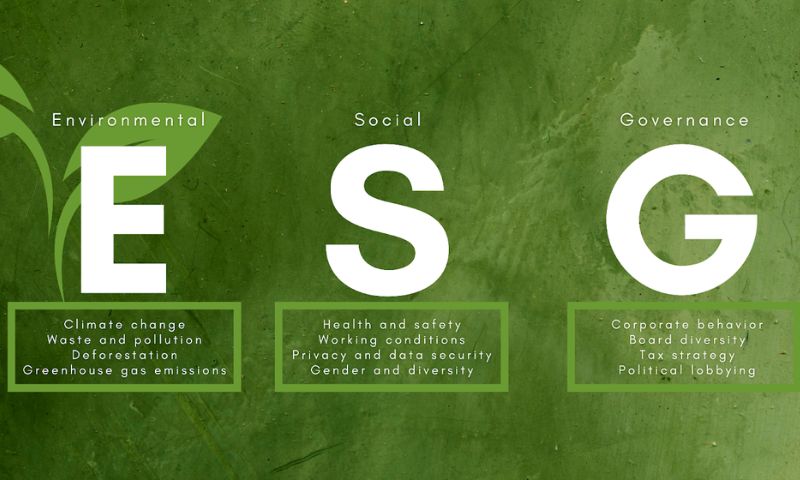Benefits and Drawbacks of ESG Investing: Making Green While Staying Green? As the world tilts towards sustainability, you’ve likely heard about ESG investing. It promises a win-win: padding your wallet while protecting the planet. But is it really that simple? In this post, I’ll unveil the truth behind the buzz, delving into the good and the less-good of ESG. Ready to see what goes on behind the green curtain? Let’s dive in.
Understanding the Rise of ESG Investing
What Are ESG Investment Advantages?
Have you asked about ESG investment advantages? They’re about doing well while doing good. First off, ESG investing can give solid returns. Companies that care about the environment, social issues, and good leadership often do better. They dodge risks that can hurt their business.
Now, let’s break it down more. Ethical investing outcomes go beyond money. They bring changes for people and the planet. Your cash pushes firms to slash pollution, treat people fairly, and run things smoothly. You help the world and build wealth. That’s a double win.
What’s the deal with environmental social governance factors? Well, they’re the heart of ESG. They’re like a health check for companies, but for how green and good they are. Let’s get into some details:
- Environmental: This is all about the planet. We’re talking cutting carbon footprints and investing in things like renewable energy funds.
- Social: Here it’s about treating people right. From fair pay to safe work, it matters.
- Governance: Good bosses make good decisions. That’s governance. It’s about running a company right, no sneaky business.
Putting ESG strategy in your portfolio could help you in the long run. Green bonds investing or sticking to ESG funds performance might just be smart moves for both your conscience and future.
Deciphering Environmental Social Governance Factors
Diving into environmental social governance factors gives you the full picture. Investors use ESG criteria for investors to pick winners. Companies that score high on these are often in it for the long haul. They deal with stuff like climate change and investing with eyes wide open.
Now, ESG’s not just about trees and good vibes. It’s about lowering risks. Think about it. A company that’s wrecking the planet or treating folks poorly? It could run into big trouble, like laws changing or people boycotting it. But a company that’s playing nice with nature and people? It stands tall when storms hit.
Governance factors in investment are huge too. A firm that runs like a well-oiled machine? That’s a firm you can trust. And trust means steadier stock prices and maybe even stronger shareholder value.
Sure, there are challenges. ESG reporting standards can be tricky. Not all companies tell you straight up how they’re doing. ESG challenges for investors are real. You’ll need strong ESG due diligence and maybe even exclusionary screening of investments. The goal is clear: find firms that match your money goals and your values.
This part is cool: shareholder activism ESG can push companies to do better. And that’s important, right? Our money should shout for what we believe in.
So there you have it. Making green doesn’t mean you can’t be green. With a smart ESG plan, you can aim for both cash and kindness. And that’s something worth investing in, don’t you think?

The Financial Implications of ESG Investing
Analyzing ESG Investing Returns
When we talk about ESG investment advantages, budding investors ask: “Do ESG investments really pay off?” The short answer is yes. Over time, many ESG funds have shown strong returns. They often match or beat non-ESG funds. People are starting to see that going green does not mean lesser green in their wallets.
Investments that focus on environmental social governance factors can offer real perks. We’re not just talking about feeling good about your choices. We’re talking cold, hard cash. These funds often have lower risks. Big troubles like oil spills can hit a company’s wallet hard. If you invest in companies that avoid such risks, your money is safer. Plus, these firms are getting ready for the future where renewables rule.
Yet, there lies the rub. It’s not all sunny. Some ESG investment disadvantages need a mention. Green investing risks are real. Some ESG-minded firms may not make profits fast. That can slow down your cash growth. Ethical investing outcomes are not always predictable. Conventional investments can sometimes score quick wins. But here’s the deal. ESG investing is about the long game. Patience is key. You’re planting seeds for future wealth while helping the planet.
The Correlation Between Corporate Social Responsibility Impacts and Shareholder Value
Now let’s dig a bit deeper. How does corporate social responsibility impact shareholder value? Companies that treat people and the planet right tend to win big loyalty. That loyalty turns into stable, sometimes growing, stock prices. So yes, doing the right things can pay off.
When firms show they care about more than just money, they often gain trust. That trust translates to more folks wanting to buy their stocks. Think of it as a trust bump in value. ESG criteria for investors offer a guide to find these golden geese.
But, we must talk about short-term costs. Sometimes these good deeds can dip into profits. Ending ties with bad players can mean spending money to find new partners. More cash might flow into making products safer. These moves can make some investors nervous. Yet, here’s the scoop – this can lead to lasting value. It draws in investors that stick around. It can even spark shareholder activism ESG style. That’s where shareholders push companies to do better for the world.
Long story short, considering ESG factors in your portfolio isn’t just nice; it’s smart. The right ESG strategy can mean solid returns while backing your values. It weaves financial returns with social good. A strong ESG game can help spot firms ready for tomorrow. And yes, in the long run, it can lead to fuller pockets.
Don’t shy away from ESG due diligence. Look at how the companies in a fund treat their world. And then, look forward to growth in your investments and in your heart. Because, sometimes, the best return is knowing you’re investing in a better future.
Navigating the Complexities of ESG Investment
Acknowledging Green Investing Risks and ESG Investment Disadvantages
When we talk about ESG (Environmental Social Governance) investing, most chat about the good stuff. Things like how it helps the world or makes money doing good. But, like any choice we make with our wallets, it’s not all sunshine. So, let’s be real about the tough bits, too.
First, let’s unpack something called ESG investment disadvantages. This isn’t just a fancy term; it’s a real deal. Some say ESG funds don’t always beat other stocks. They worry that focusing too much on doing good might mean making less money. And yeah, they’ve got a point—sometimes. But not always. Life’s about balance, right? Well, so is smart investing.
Another pickle is green investing risks. “Green” sounds safe, but it can be tricky. You might pick a company that seems good for the earth. But later, you find out it wasn’t so clean after all. That stings, for the planet and your pocketbook.
And about those fancy ESG ratings? They rate how good a company is at ESG stuff. Sounds great, but here’s the snag: not everyone rates the same way. What’s a green star for one rater could be a “meh” for another. Choosing gets hard.
So, think of ESG like a jungle gym. Fun to climb but you’ve got to watch your step.
ESG Compliance and Profits: The Balancing Act
How do we keep our cash and conscience happy? Let’s talk about squaring ESG compliance and profits.
The real talk is this: people want to make money and feel good about where it’s coming from. ESG strategy in your portfolio means you try to hit both. You might go for ESG funds that ditch the bad like oil or guns. Or, chase the good like clean air and happy workers.
But here’s the twist: some ESG champs might not make as much dough at first. And that’s okay. Investing is a long game, just like taking care of the world. If we play our cards right, both can pay off in the end. ESG investing returns might surprise you over time. The wins might be slower but steadier, and when the world’s smiling, your wallet might too.
Think of it like planting a tree. Today it’s small, but give it time, and it could be your favorite spot for shade.
And for the brainy stuff, we’ve got things like carbon footprint reduction investing. Here’s where you back stuff that’s cutting down on what’s heating up the planet. This is a no-brainer win-win. Less heat, more green in more ways than one.
Alright, so what’s the takeaway from all this chat about profits and doing right by the world? It’s this: with a little wisdom and patience, you can have your cake and eat it, too. That means making money while making a difference. Sounds pretty sweet, right?
Just remember it’s about the long haul, the big picture. We’ve got to keep our eyes on both the green of the earth and the green in our wallets. That’s the ESG balance act, folks.

Evaluating the ESG Landscape for Long-term Success
The Role of ESG Funds Performance in Investment Portfolios
Investing is not just about money. It’s about making choices that shape our world. ESG funds blend these ideas. They aim for solid returns and positive impact. People ask, do ESG investments add value? Yes, they often do. They consider more than just profits. This leads to smarter choices and can help avoid losses. These funds look at how companies treat our planet, people, and their own leadership.
Companies that rank high with environmental social governance factors can be less risky. Good ESG scores suggest that a company is thinking ahead. It also shows they care for more than immediate gains. This can attract investors who want their money to do good. If a firm ignores climate change or treats workers poorly, it may face lawsuits or boycotts. These can hurt its stock price and scare away investors.
Good ESG strategy in a portfolio helps manage risks. It works like a safety check for your investment dollars. Ethical investing outcomes are about more than feeling good. They’re about making good financial sense, too. Balancing financial returns with social good can seem tough. But consider this, companies with strong social or environmental practices often see loyal customers stick by them.
ESG investing returns hinge on picking funds that align with solid ESG criteria for investors. This may lead to long-term sustainability in investments. It can mean investing in renewable energy funds instead of old energy sources that may decline. Or it could be choosing companies that focus on a smaller carbon footprint. These choices could pay off as the world works toward a cleaner future.
Socially responsible investing ROI can stem from shared values. When a company’s values match those of its customers, it can foster deeper loyalty. Moreover, good practices can also reduce company costs. Think about waste reduction in manufacturing. It lowers both expenses and environmental harm. Companies focused on governance factors in investment decisions might seek long-term growth over short-term profits. They might stave off scandal-related stock drops, too.
ESG Metrics for Investment Analysis and ESG Reporting Standards
Reporting standards are key for evaluating ESG funds. These standards let us see beneath the surface. We can see if a company is truly ESG compliant. Or if it’s just making grand claims. That’s why we use ESG metrics for investment analysis. These metrics look at everything from energy use to CEO pay. They shed light on how a firm runs and its actual impacts.
The upside of ESG funds is clear. They hold companies to higher standards. This can push entire industries toward doing better. The downside is that ESG reporting can be tricky. Companies have lots of ways to measure impact, and not always with clear rules. Investors face a tough task. We must read between the lines to spot true ESG leaders. This calls for ESG due diligence on our part.
A challenge for investors is staying up-to-date with ESG controversies and investment trends. Take shareholder activism ESG as an example. It shows growing pressure for real change. Activist investors use their shares to push for greener practices. These movements can change how a company operates.
Investment diversification with ESG means not all your eggs are in one basket. But with ESG, it’s a greener basket. A mix of green bonds, clean tech, and firms with top ESG ratings can spread out risks. Yet it also aims for positive growth that meets ethical benchmarks.
To wrap it up, ESG funds can perform well while doing good. But, it takes care, insight, and a bit of sleuthing to get it right. We must keep our eyes open. We need to look beyond the buzzwords. Real value lies in finding companies that are true to their word and kind to the world.
In this post, we dug into what ESG investing means and why it’s gaining ground. We learned how it can bring benefits, not just to our planet and society, but to investors as well. We saw the positive link between doing good and good profits. Then, we faced the truth: ESG isn’t simple. There are risks and it’s tough to get right all the time. But we also found ways to make it work, how to balance the need for money with the need to do right.
As someone deep in the field, I’m convinced that ESG investing is not just a trend. It’s reshaping how we think about where our money goes. If we track ESG funds with care and keep our eyes open, we can back up our values and can also look forward to possible rewards. Here’s to investing in a future we all believe in. Let’s keep learning and keep pushing for profits that help, not hurt.
Q&A :
What are the potential advantages of ESG investing?
The key benefits of Environmental, Social, and Governance (ESG) investing include the opportunity to support sustainable and ethical business practices, the potential for risk mitigation since ESG factors can influence a company’s long-term performance, and the alignment with personal values for socially conscious investors. Furthermore, ESG investing can lead to competitive financial returns as markets increasingly acknowledge the value of sustainability.
How could ESG investing negatively impact financial returns?
While ESG investing can offer competitive returns, there are concerns that it could constrain investment opportunities by excluding certain profitable industries or companies. It’s also suggested that the increased demand for ‘green’ investments might inflate the value of ESG-compliant assets, potentially leading to lower yields. Additionally, the cost of rigorous ESG analysis and reporting might get passed on to the investor, affecting net returns.
Can ESG investments outperform traditional investments?
There is a growing body of evidence to suggest that ESG investments can, and often do, outperform traditional investments. As sustainability becomes a pressing global issue and as companies that focus on ESG issues may also exhibit better risk management and innovation, these factors can translate into strong financial performance. However, outcomes may vary depending on the market conditions and specific investment choices.
What should investors consider before engaging in ESG investing?
Before investing in ESG-focused funds or companies, investors should consider their personal investment goals, time horizon, and risk tolerance. They should also research how ESG criteria are applied and how comprehensive it is since there is no universally accepted standard for what constitutes an ESG-compliant investment. Additionally, evaluating the track record and performance metrics against traditional benchmarks is important.
Is ESG investing just a trend or here to stay?
ESG investing has experienced significant growth over the past decade and is considered more than a trend by many industry experts. With increasing awareness of global issues such as climate change, social justice, and corporate governance, both investors and companies are acknowledging the long-term value of responsible investing. Regulatory trends and shifts in public sentiment also indicate that ESG will continue to be a significant factor in the investment landscape.




